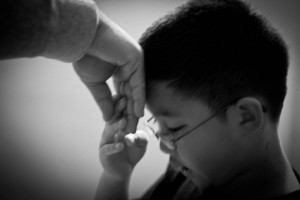Culture affects children’s mann ers, says etiquette expert Pauli Antoine Porquez Genuino, president of image and social graces training companies Red Archon and Etiquette de Manille. It is especially important to consider the common activities typical Filipino families engage in and how these influence the behavior of children. Read on for tips on how you can raise well-mannered kids the Pinoy way.
ers, says etiquette expert Pauli Antoine Porquez Genuino, president of image and social graces training companies Red Archon and Etiquette de Manille. It is especially important to consider the common activities typical Filipino families engage in and how these influence the behavior of children. Read on for tips on how you can raise well-mannered kids the Pinoy way.
When relating with other people
1. “Po,” “opo,” and “paki”
Traditionally, using “po” and “opo” is a more respectful way of conversing with elders. Get your tot into the habit of responding to grown-ups using these polite Filipino words. Genuino also encourages parents to train their kids to always say “puwede po bang” or “paki” when asking for a favor.
2. “Mano po”
Marilet Delgado-Anastacio, a registered guidance counselor at Miriam College Grade School, thinks parents should encourage their kids to practice pagmamano, as it is a beautiful Filipino tradition of greeting the elderly where one gently takes the hand of the elder and kisses it or places it on one’s forehead.
3. “Tao po!”
Aside from the usual practice of knocking on closed doors and waiting for a response before entering, Filipinos usually call out “Tao po!” whenever visiting someone’s home. This is to signify one’s presence in another’s home.
4. Igalang si Yaya.
Having a yaya or a kasambahay is common in many Filipino households. Parents should be good role models when it comes to dealing with them. Remind your children to treat helpers (and everyone else they meet) with kindness and respect.
5. Paggalang sa nakatatanda.
Aside from using “po” and “opo” and practicing pagmamano, children must also remember to give way to the elderly, especially in public. The same courtesy should be extended to pregnant women and people with disabilities.
6. Ate, Kuya, Tito, at Tita
Another distinctly Filipino way of showing respect for grown-ups is to not call them by their first names. Tell your child that it would be nice to address older people as ate, kuya, manong, manang, and even lolo or lola. It is also okay to address the friends of his parents as tito and tita, even if they are not his relatives.
During mealtime
7. Kutsara at tinidor—o kamayan
Unlike in other countries where it is common to use a knife and a fork during mealtimes, Filipinos like to eat using a spoon (kutsara) and a fork (tinidor). Show your child the proper way to hold his utensils while eating. Teach him that it is improper to tap his spoon and fork together to remove bits of food from his utensils. When he is a little older (and no longer makes a mess or plays with his food), teach your child how the locals like to eat their food best: kamayan. Tell him that serving spoons are still to be used even during kamayan sessions, and that only one hand should be used when doing so. Licking both hands is a no-no (and the same goes when using utensils, too!). Table manners also include not overloading your plate with food. Remind your child to get just enough food he can finish.
8. The Pinoy hospitality
It is customary for Pinoys to invite others to join them for a meal. When your family has guests over at your home, teach your child to be a gracious host by offering the guests something to eat or drink as soon as they arrive. And if you are throwing a party at home, remind your child to let the guests (especially the grown-ups) help themselves to the food first before he partakes of the meal.
At Church and in other people’s homes
9. “Bless po, Father.”
Encourage your child to ask for blessing of the priest or pastor after mass or service. This is one way of saying thanks to him, honoring him, and recognizing authority.
10. Shoes off
Genuino encourages parents to teach their children to take off their shoes before entering someone’s house if the owner walks barefoot inside his home. When visiting a playmate, it is also important that your child respectfully greet his friend’s parents or the homeowners and properly say “good-bye” and “thank you.” Encourage your child to look people in the eye, and remind him to always be gracious and at his best behavior when in other people’s homes.
Genuino says, “One of the best things we can teach our kids is proper table etiquette. Children who learn it at a young age tend to practice good manners throughout their lives.
When children are equipped with skills, they become confident, learn how to cope, and behave well in different situations as they grow. Praise your kids, use positive motivation, and show them that you are proud of their new skill.”
Stages and ages
Follow this guide to know what to expect from your child when it comes to teaching him about manners.
1 to 2 years – Start introducing the concept to your child through modeling.
3 to 5 years – The child should be able to practice good manners with constant but gentle reminders.
6 to 7 years – The child should be able to practice good manners (but inconsistently).
8 years and older – The child should be able to practice good manners without being reminded to do so.
http://www.smartparenting.com.ph/parenting/pinoy-parenting/10-manners-pinoy-kids-should-know







